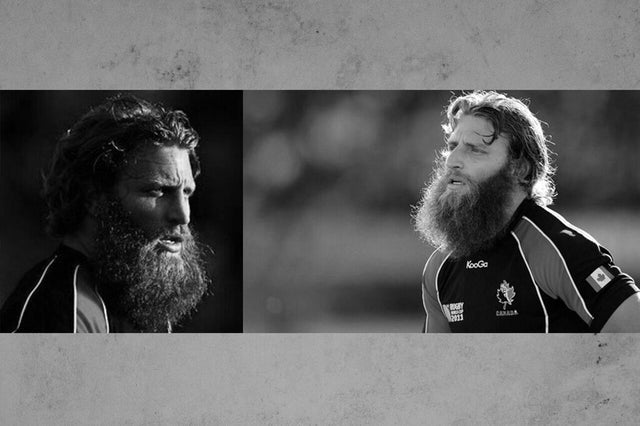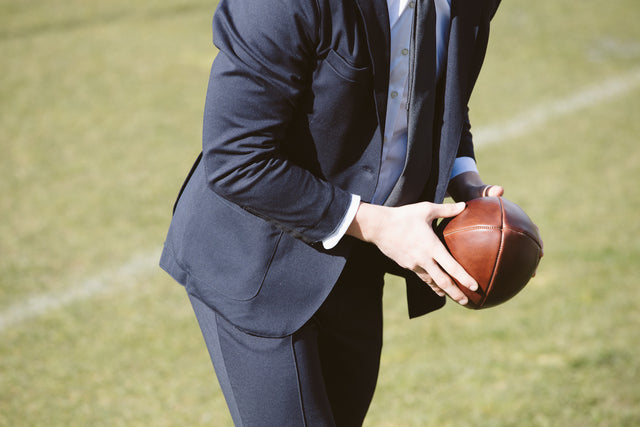Leaders Lead Themselves: Adam Kleeberger runs Inaugural Rugby Canada Academy
Written By: Adam McQueen
The 2011 Rugby World Cup was a campaign full of fond memories for Canadian rugby fans. Their team took on the mantle of tournament darlings as fans across the globe became enamoured with their colourful personalities and feisty underdog persona.
No player embodied this more than Adam Kleeberger, the Canadian openside flanker who spent the entire tournament doing his best impersonation of a human torpedo. While Kleeberger’s exploits on the field caught the eye of many, his role as one of the three Canadian ‘Beardos’ – alongside Hubert Buydens and Jebb Sinclair donning prominent lumberjack beards – received an equal amount of media attention.
The defining moment of Kleeberger’s World Cup came against the eventual winners of the tournament, the All Blacks. In the late stages of the game, already up fifty points, New Zealand prop Tony Woodcock looked set to stroll over for a try in the corner of the pitch. However, Kleeberger launched himself, from what seemed to be the third row of the stands, into the mammoth of a man to prevent a surefire try whilst knocking himself unconscious in the process.
This brief sequence of events encapsulated the fine line between unparalleled commitment and reckless abandon that Kleeberger played with throughout his ten year career wearing the red and white jersey.
Unfortunately, this level of heroism comes at a cost. Several nerve, back, and shoulder injuries derailed the latter stages of Kleeberger’s playing days, which ultimately led to his retirement only months before the 2015 Rugby World Cup.
Fast-forward three years, and Kleeberger is back. Now the Strength and Conditioning coach at the newly founded Rugby Canada Academy, the former ‘Beardo’ is set to prepare the future generation of Canadian rugby.
Immediately after Kleeberger’s playing years, the University of Victoria graduate used his kinesiology degree to work alongside various other sporting teams as a member of the Canadian Sports Institute at the Pacific Institute of Sports Excellence. Kleeberger assures that this momentary ‘breakup’ with rugby was essential to help bring closure to his career.
“It is hard to let go of being a player sometimes. It was important stepping away and getting time to get some perspective.”
However, the allure of the oval ball came knocking once again this past summer.
The inaugural Rugby Canada Academy, beginning in September 2017, acquired Kleeberger as their Lead Development Strength and Conditioning coach. The opportunity to lead a high-performance program for up and coming high school athletes with national aspirations was the perfect fit for Kleeberger’s transition back into rugby.
"I wasn’t actively pursuing a switch back to rugby, but it was an area I wanted to be back in again. Obviously, I have a passion for the sport and I think I have more to add to the rugby community,” Kleeberger notes. “I think it is a natural fit for me to be involved in this kind of a role. It gives me the opportunity to develop as a coach as well as working with younger age athletes.”
 The academy is comprised of eight girls and two boys in this, its inaugural year. Their selections are based on provincial union recommendations and talent identification camps. These athletes, ranging from Grades 10 to 12, engage in a ‘blended program’ throughout the academic year that sees them satisfy their athletic requirements in the morning with Kleeberger, and then spending the afternoon with their respective schools focusing on schoolwork.
The academy is comprised of eight girls and two boys in this, its inaugural year. Their selections are based on provincial union recommendations and talent identification camps. These athletes, ranging from Grades 10 to 12, engage in a ‘blended program’ throughout the academic year that sees them satisfy their athletic requirements in the morning with Kleeberger, and then spending the afternoon with their respective schools focusing on schoolwork.
So what is the overarching goal of the program?
“Our personal purpose of the program is ‘Leaders Lead Themselves’. We want to create young kids who leave the program and are able to be self-sufficient, to be able to lead themselves through their sporting life, academic life, social life, emotional life, whatever it is,” Kleeberger explains. “We want them to be resilient and robust people coming out of the program in all aspects, and we want them to add to their communities.”
The structure of the athlete’s mornings has been built to mirror a typical day for a fully centralized athlete competing for the national 7s or 15s team. Each morning, Kleeberger leads the group through a weight session focused on either strength, mobility, or injury prevention. They then engage in rugby-specific skills and video sessions predicated on the outlined key themes of the national team. As the program has developed, they have set up various seminars with guest speakers to talk about sports nutrition, coaching, and sports psychology.
While physical and mental preparation should bridge the gap between school competition and the international level, the exposure to high-level performance is the key ingredient for the academy’s success, Kleeberger notes.
“You don’t know what you don’t know. It is hard to expose them to that [international level] unless they are training and competing with the national team. We will actually have training sessions with the senior team, so there is a nice little intermix between us. The younger guys and girls get to have a look at what the senior team does and how they prepare, and get a bit of exposure as to what it is like to train as a national team athlete.”
The academy is currently made up of predominantly British Columbia-based athletes due to logistical and financial constraints, however the program will look to expand its reach to out of province athletes in coming years.
“We wanted to make sure that there wasn’t an exclusive program due to financial reasons, so we followed the model we are building on, which is that any player invited will not have to pay to be a part of the academy,” Kleeberger says of the initial setup. “We are actively looking for athlete sponsorships to help athletes from out of province that aren’t able to access the program at this point in time.”
The latter part of high school is a pivotal moment in which teenagers gravitate towards a specific sport to pursue, and Canadian rugby needs an advantage to ensure athlete retention. This ability to provide a professional development structure is integral for rugby to keep top level talent that may be swayed by the endless list of sports available in the country.
Many concerned voices in the rugby community rightly express the need for grassroots rugby to become a focal point throughout the country. The adoption of the Rugby Canada Academy does not come at the expense of this pursuit. The academy can instead become a key cog in an entirely new development structure, setting a template that can be followed and strengthening lines of communication with provincial unions and clubs.
“Our development model was kind of non-existent for a little while and we were just dumping money into guys at the top end without giving attention to guys who were on the up and up,” Kleeberger reflects about previous national team initiatives. “As an organization, we cannot expect to micromanage everything. There are great resources in our university system, our club system, and our provincial systems that we can be better at interacting with to enhance the community as a whole, rather than trying to do everything ourselves.”
The Rugby Canada Academy sits atop of the development system, working directly with identified potential future Olympians who do not have access to the necessary resources.
Regional academies train the next tier of players. So long as athletes who are part of these academies maintain a presence in the school and club system, the overall quality of these grassroots programs will be strengthened.
The academies do not need to become identical, but they must collaborate with one another, Kleeberger says.
“I don’t think we can take this program and plop it down anywhere and it would have the same effect. But there is a value in us having this experience and being able to share this amongst other organizations. There are some places that are doing similar things and are having great success.”
Athletes in the Rugby Canada Academy are encouraged to play in the club system, many of which are members of the newly re-established Westshore club. Although the partnership with Belmont High School has resulted in many athletes attending the school, Kleeberger hopes to diversify the pool of players throughout the island.
“I really don’t want it to be a situation where we are centralizing everybody and creating one club in which one school is benefitting. If they do come from other places in Victoria, it is easy to bring them in and provide training that they can hopefully take back to their high school and club teams.”
As with any program in its first year of existence, the academy has been under a constant state of evolution. The coaching staff have made tweaks as they gauge how their athletes respond best. However, simply being a constant presence in the athlete’s life has been the greatest learning experience for players and coaches alike.
“I think the biggest thing is contact time. We cannot really do anything with an athlete when we meet once a week or once a month. These things take time to develop and grow,” Kleeberger explains. “For me, being able to learn how they learn helps me make a better impact on their training.”
Kleeberger hopes that players can learn to successfully balance academics with training, an inevitable part of competing in an amateur sport. He also sets his eyes on creating national team talent.
“I would like to see some of our athletes make the transition into being a member of the Senior Teams. Physically I want them to be able to jump into that training environment and hit the ground running. I don't want them to have to take backwards steps or do remedial work before they can actually start to train at that level which has been an issue in the past.”
Before they expand upon their circle of influence, the academy’s immediate goal is to create the best product possible. Halfway through the yearlong test run, Kleeberger is pleased with their progression, but understands there is plenty more work to be done.
“Before we start to extol the virtues of the program we want to make sure that the virtues we are trying to achieve are being achieved.”
If the former World Cup hero is as committed to his coaching role as he was each time he put on his country’s jersey, then the future of Canadian rugby is in good hands.



